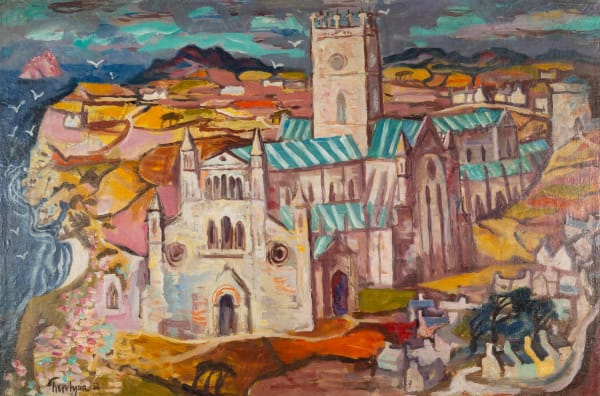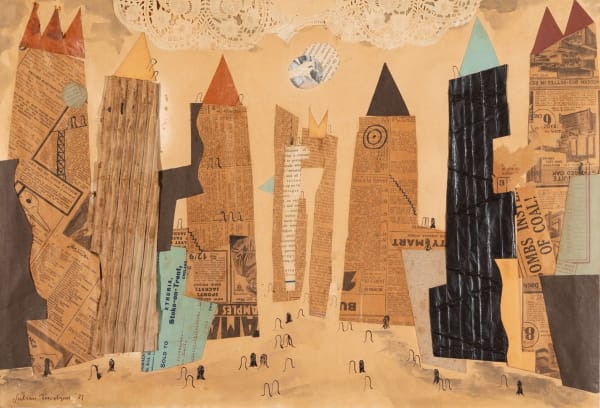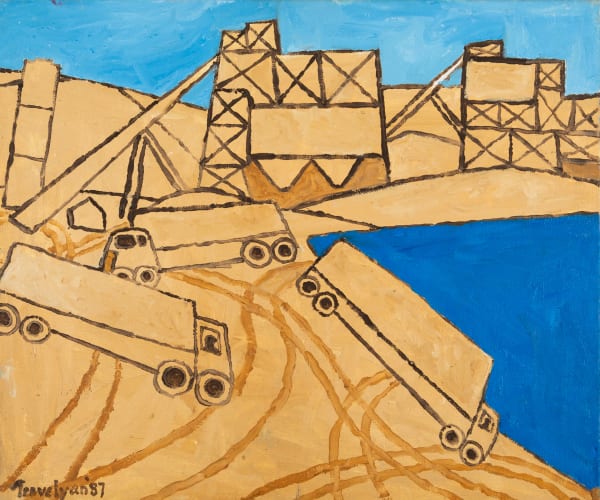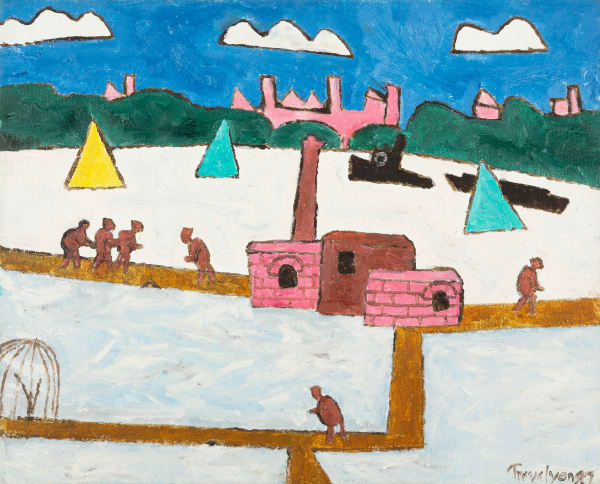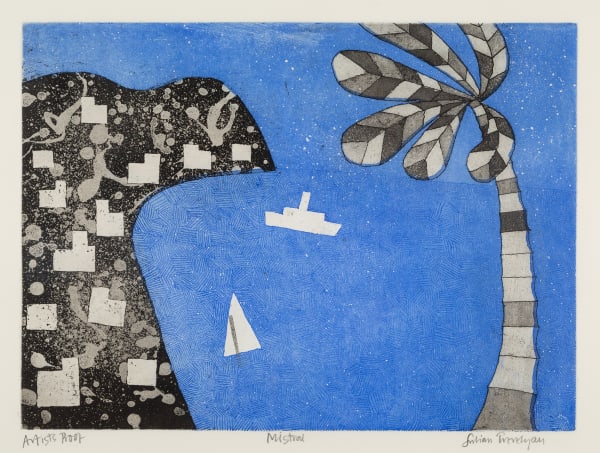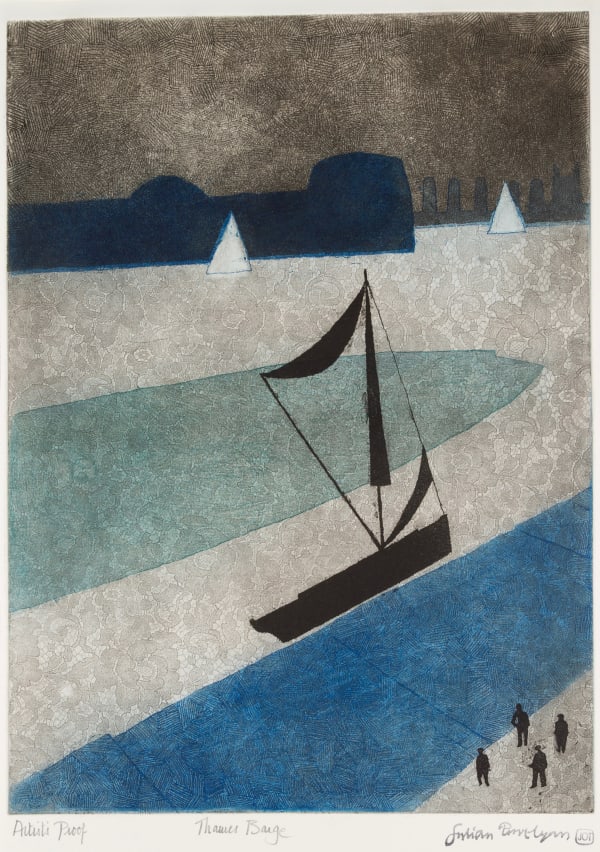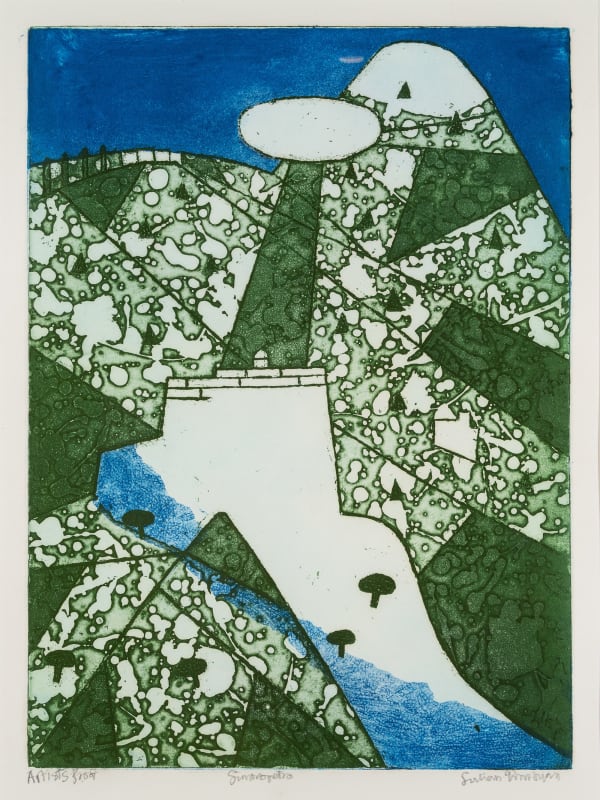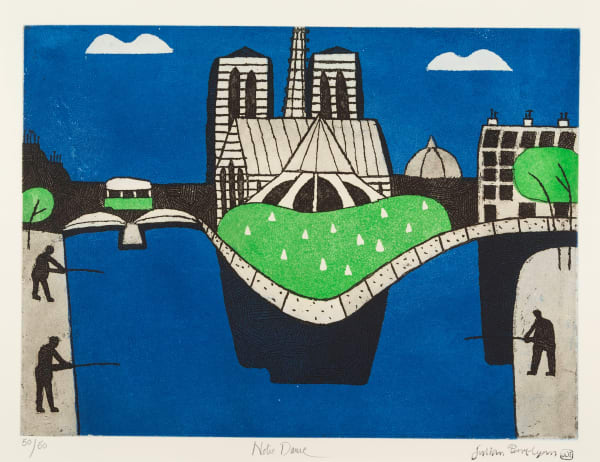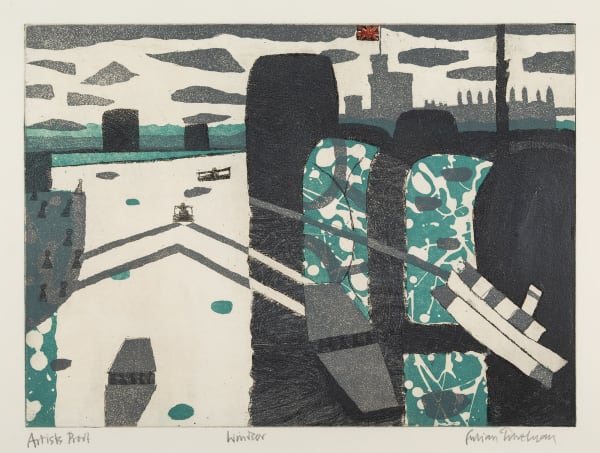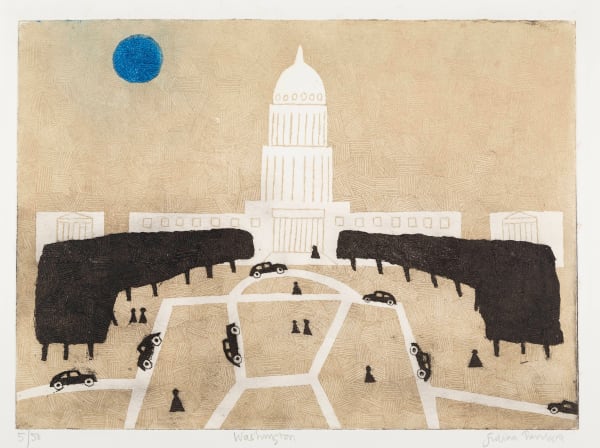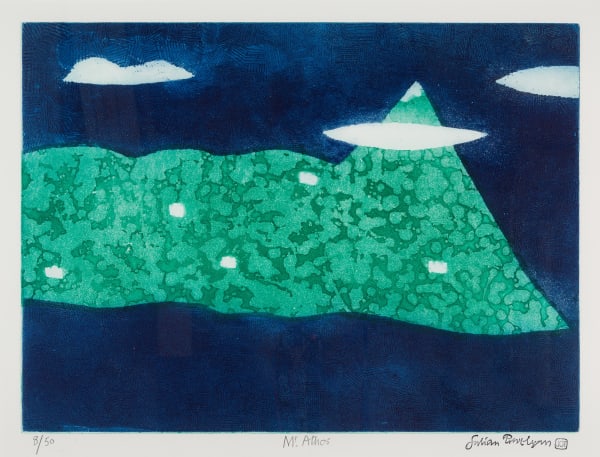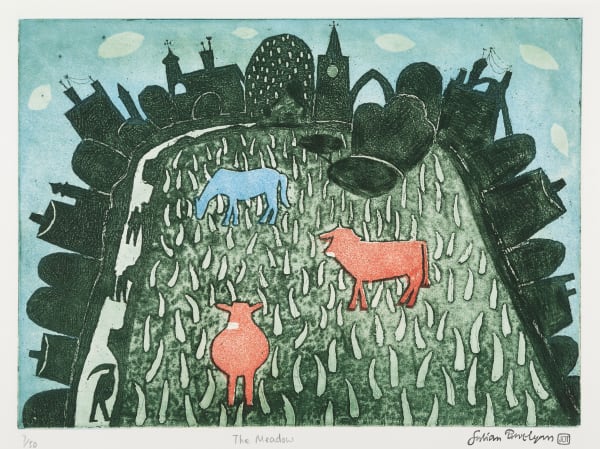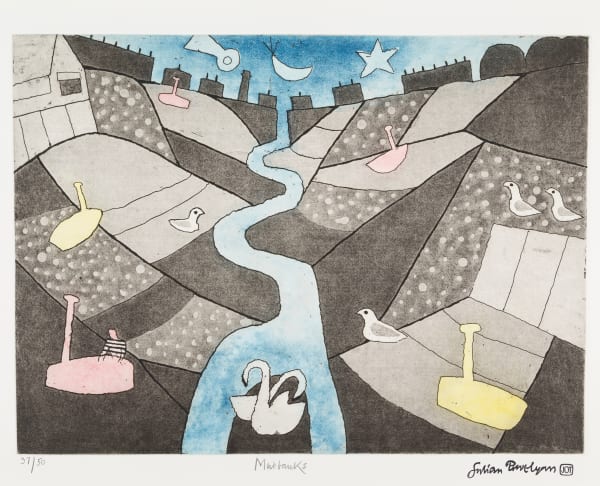Julian Trevelyan Art for Sale1910-1988
Jenna Burlingham Gallery will be holding an exhibition of works from the Estate of Julian Trevelyan, 'Tides and Travels', from 14th June to 12th July. The full catalogue will be available in early June and the website will be updated at around the same time.
This selection of previously unseen paintings, collages, etchings and lithographs which come direct from the Estate of Julian Trevelyan illustrate the breadth of Trevelyan's vision, in which oils and prints hold equal weight. Having trained in Paris under Stanley Hayter at Atelier 17, working alongside artists including Alexander Calder, André Masson and Joan Miró, experimentation was central to Trevelyan's work. His palette is both bold and lyrical; his compositions marked by a sense of rhythm and visual wit. In the words of his wife, Mary Fedden, '... whichever medium he was involved in, his passionate concentration was total ... Julian invented such a marvellous graphic language, he pushed his personal vocabulary to the limits.'
The prints and oils span six decades, from the 1930s to the 1980s, and fall into two broadly thematic groups. Tides: inspired by Trevelyan's home and studio space in Durham Wharf, situated on the edge of the Thames in Chiswick, and his local stomping ground. Travels: inspired by Trevelyan's visits with Mary Fedden to destinations including France, Italy, Holland, America and India in the 1980s. Views are distilled into poetic patterns which tread a fine line between realism and abstraction; landscapes though familiar are never weighed down by too much detail.
Proceeds from the sales will raise funds for the redevelopment of Durham Wharf by Turner Prize Winning Architects, Assemble, and the establishment of a long-term artists' residency programme, the aim of which is to ensure that Durham Wharf continues to be a place where creativity, community and artistic excellence can thrive for years to come.
-
 St Davids, 1950
St Davids, 1950 -
 At the Wharf, 1945
At the Wharf, 1945 -
 The Ganges (Benares), 1968
The Ganges (Benares), 1968 -
 City, 1937
City, 1937 -
 Pleasure Steamer (Thames Boat), 1962
Pleasure Steamer (Thames Boat), 1962 -
 Le Dantou, France, 1980
Le Dantou, France, 1980 -
 Tow Path, 1988
Tow Path, 1988 -
 Gravel Pits, 1987
Gravel Pits, 1987 -
 Airport, 1965 Reserved
Airport, 1965 Reserved -
 Bridges, 1938
Bridges, 1938 -
 Soil Erosion, Tuscany, 1959
Soil Erosion, Tuscany, 1959 -
 Sailing, 1978
Sailing, 1978 -
 The Rock, Holland, 1988
The Rock, Holland, 1988 -
 Mistral, 1974£ 3,250.00
Mistral, 1974£ 3,250.00 -
 The Lookout, 1984£ 2,500.00
The Lookout, 1984£ 2,500.00 -
 Building the Thames Barrage (sic), 1980£ 2,500.00
Building the Thames Barrage (sic), 1980£ 2,500.00 -
 Woolwich Barrier, 1980£ 2,500.00
Woolwich Barrier, 1980£ 2,500.00 -
 Pool of London, from the Thames Suite, 1969 Reserved
Pool of London, from the Thames Suite, 1969 Reserved -
 Thames Barge, 1984£ 2,250.00
Thames Barge, 1984£ 2,250.00 -
 Tower Bridge, 1968£ 2,250.00
Tower Bridge, 1968£ 2,250.00 -
 Flood Tide, 1979£ 1,950.00
Flood Tide, 1979£ 1,950.00 -
 Simone Petra, Greece, 1981 Reserved
Simone Petra, Greece, 1981 Reserved -
 Notre Dame, Paris, 1980£ 1,850.00
Notre Dame, Paris, 1980£ 1,850.00 -
 Henley Regatta, 1978£ 1,850.00
Henley Regatta, 1978£ 1,850.00 -
 Ram, 1978£ 1,850.00
Ram, 1978£ 1,850.00 -
 Harbour, 1976£ 1,850.00
Harbour, 1976£ 1,850.00 -
 Richmond, from Thames Suite, 1969£ 1,850.00
Richmond, from Thames Suite, 1969£ 1,850.00 -
 Windsor, from the Thames Suite, 1969£ 1,850.00
Windsor, from the Thames Suite, 1969£ 1,850.00 -
 Tower Bridge, from the Thames Suite, 1969£ 1,850.00
Tower Bridge, from the Thames Suite, 1969£ 1,850.00 -
 Pleasure Steamer (Thames Boat), 1968£ 1,850.00
Pleasure Steamer (Thames Boat), 1968£ 1,850.00 -
 The Bridge, Hammersmith, 1985£ 1,750.00
The Bridge, Hammersmith, 1985£ 1,750.00 -
 Water Music, 1984£ 1,750.00
Water Music, 1984£ 1,750.00 -
 West Wind, 1983£ 1,750.00
West Wind, 1983£ 1,750.00 -
 Pennsylvania, from the America Series, 1982£ 1,750.00
Pennsylvania, from the America Series, 1982£ 1,750.00 -
 Mount Kisco, New York, from the America Series, 1982£ 1,750.00
Mount Kisco, New York, from the America Series, 1982£ 1,750.00 -
 Washington, from the America Series, 1982£ 1,750.00
Washington, from the America Series, 1982£ 1,750.00 -
 Mount Sinai, Egypt, 1981£ 1,750.00
Mount Sinai, Egypt, 1981£ 1,750.00 -
 Mount Athos, Greece, 1981£ 1,750.00
Mount Athos, Greece, 1981£ 1,750.00 -
 Entre Deux Mers, Bordeaux, 1979, circa£ 1,750.00
Entre Deux Mers, Bordeaux, 1979, circa£ 1,750.00 -
 The Meadow, 1978£ 1,750.00
The Meadow, 1978£ 1,750.00 -
 Mudbanks, 1978£ 1,750.00
Mudbanks, 1978£ 1,750.00 -
 Gulls, 1977-1978£ 1,650.00
Gulls, 1977-1978£ 1,650.00 -
 Holland, 1975£ 1,650.00
Holland, 1975£ 1,650.00 -
 Kilns, 1979£ 1,450.00
Kilns, 1979£ 1,450.00 -
 The Watchers, 1984£ 1,350.00
The Watchers, 1984£ 1,350.00 -
 Delft, Holland, 1979£ 1,250.00
Delft, Holland, 1979£ 1,250.00 -
 Sails, 1982-1983 Reserved
Sails, 1982-1983 Reserved -
 Harbour (from School Prints), 1946£ 900.00
Harbour (from School Prints), 1946£ 900.00
Julian Trevelyan was an important British artist in the twentieth century.
The only child of poet Robert Calverley Trevelyan and his wife Elizabeth van der Hoeven, his grandfather was the liberal politician Sir George Otto Trevelyan and his uncle was the historian George Macaulay Trevelyan.
Trevelyan was educated at Bedales School and Trinity College, Cambridge, where he read English Literature. He moved to Paris to become an artist and enrolled at Atelier Dix-Sept, Stanley William Hayter's engraving school, where he learned about etching. He worked alongside artists including Max Ernst, Oskar Kokoschka, Joan Miró and Pablo Picasso.
In 1935, Trevelyan bought Durham Wharf, a group of warehouses beside the River Thames in Hammersmith, London. The place became his home and studio for the rest of his life as well as a source of endless artistic inspiration. He became a confirmed Surrealist and exhibited at the International Surrealist Exhibition, which was held at the New Burlington Galleries in London.
Trevelyan married Ursula Darwin, daughter of Bernard Darwin and great-granddaughter of Charles Darwin, but their marriage was dissolved in 1950. Their son is the film-maker Philip Trevelyan. It was in 1951 that he married the woman who became his most renowned collaborator and muse, Mary Fedden.
From 1950 to 1955, Trevelyan taught history of art and etching at the Chelsea School of Art. Between 1955 and 1963 he was tutor of engraving at the Royal College of Art, before rising to Head of the etchings department and becoming influential to many younger printmakers, including David Hockney and Norman Ackroyd.
In July 1986, Trevelyan was awarded a senior fellowship at the Royal College of Art and in September 1987 he was appointed a Royal Academician.
A Trevelyan retrospective, The Artist and His World, was held at Pallant House Gallery, Chichester in 2018.
His son has written a monograph on Trevelyan, 'Picture Language', published in 2013 by Lund Humphries.

